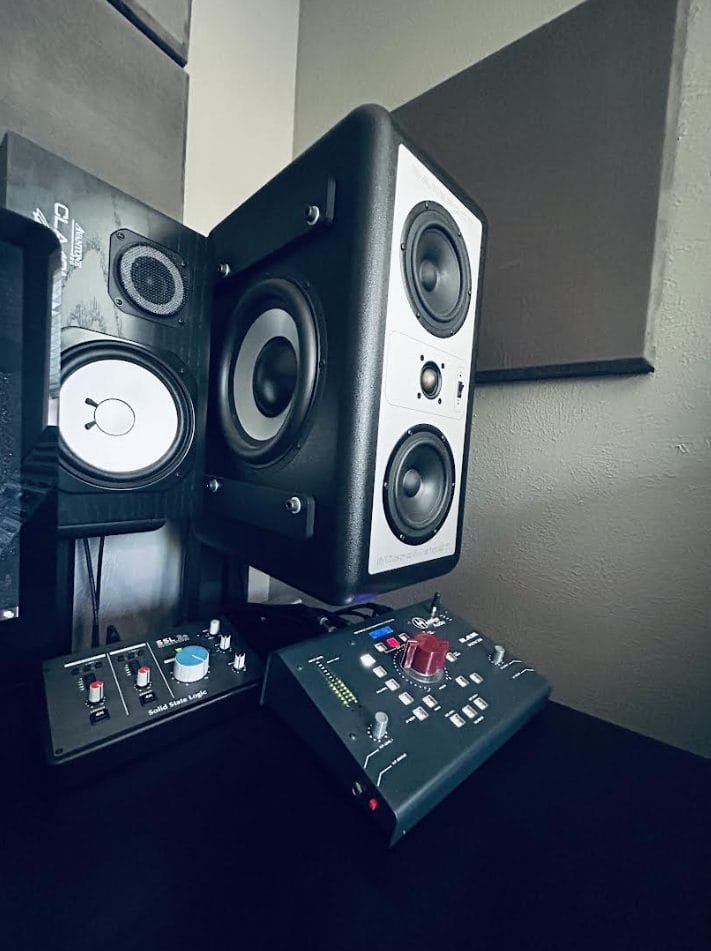Factory Planets aren’t trying to make a moment—they’re trying to make something that lasts. The Denver-based duo of Ben A and Chic Hooligan have been around long enough to know what happens when you chase hype. So instead, they’re pulling from decades of beat culture, analog gear, and ambient experimentation to create something that feels honest and unhurried. Their new EP Synthesis 1.0 is the result: a patient, loop-driven project that leans more toward meditation than momentum.
They hum, simmer, and sprawl. The textures are warm and lived-in, the rhythms slightly off-center in a way that feels human. On tracks like “Freeze That Blunt” and “I Wish,” you can hear fragments of soul, dusty MPC swing, and tape-saturated synths all moving together at a different tempo than the world outside. It’s not beat music for algorithms—it’s for long drives, late nights, and headphones.
In this interview, the duo walk through their analog chain, share why subtractive mixing still wins, and reflect on how their setup evolved through years of trial, error, and restraint. It’s a quiet, detailed window into a process that rejects noise—and still finds its weight.
How do you make sure your tools actually support the way you like to work?
Good question, with lots of trial and error from experimenting over the years in the studio with hundreds of different plug-ins and hardware. The main focus is what you want your circle of sound to be. When I write or master a track it’s always a good practice to have a reference for yourself or from the client to be able to critique the final master to. I have always used the “less is more” philosophy when using plug-ins.
This can be a critical time to make a decision with your final mix-down or premaster session. One good practice is turning off the plugin you are using and A/B the track to actually try to hear the difference at all from the plugin.

Have you ever shaped your sound around one key piece of gear?
Back in the late 90s I had a Korg MS 2000 and Micro Korg that I would definitely use in every track as far as analog gear goes. The days of one piece of analog gear is almost unheard of because once you get a synth or module you love the addictive habit starts.
Today I use the USB Aphex 500 series Rack with 2 Lindell 6X-500 preamp EQs with the Elysia XPressor 500 for my summing chain that gives each track the analog sound and shape I love. The research to find and build this analog external USB master chain took me years of research and yes, trial and error.
To this day I use this lunchbox summing chain in all of my production and sessions from mastering to bouncing drum loops, basslines through the chain to add the analog warmth and sound that you can only achieve from analog gear.
What tells you it’s time to cut something out of your setup?
Overproducing is something I try to steer clear from and is a slippery slope.
There is a point in your mixdown process that you have to identify when you are shaping or changing the sound so much you might need to go back and rewrite the sound you are chasing to save time and energy.
The common producer gets caught up in this easily because they feel adding a new plug-in is solving the dynamics when it actually might be harming the phase of the mix with spreading the sound too wide. When it comes to analog gear, that’s a difficult question to answer because if it’s a compressor or EQ or external synth module you will always have that sound or shape at the tip of your hands with the gear.
I have been in a lot of studios that have old analog gear that still blows my mind and is still relevant today in music, it just boils down to how much space you have in the studio at the time.
How do you avoid stacking gear that doesn’t fit the way you create?
Understanding the rules of mixing with the basics of EQ parameters and how to use the frequencies within your tracks to work together and not fight for space within your mix or track is step one.
This is key because if you use your ear and not your eyes in the process you can eliminate a lot of the harmful frequencies within the track or mix. Basic sound design before manipulation with color and plugins will always help you. Your sound plays a huge role in this process as well.
For example, I try not to ever compress my drums, and I spend more time in the EQ process to dial in the sound and keep them in that organic state or natural rhythm habitat. The process has taken years of working on and learning the diameters within the EQ boundaries to not over stack sounds.

What’s something you thought wouldn’t matter — but ended up being essential?
Less producing and concentrating more on the frequency I am working with. Most of the tracks within your session need attention in the mix and EQ parameters to fall into place within your session and work together not against each other. I feel basic rules are something I slept on early in my production career.
Look at it this way: if you are just beginning producing music, the rules of EQ and mixing will never really change but what will change is the sounds you use, so be mindful and work on grouping your sounds within your session to concentrate and be able to dissect your groups clearly by spending a little time organizing your sessions.
How do you keep your setup consistent without letting it get stale?
Learning and reading and watching tutorials from other producers who I trust and have researched throughout my tenure in production and creation. I also have gone through about 15 different monitor setups throughout my time in the studio and finally have stuck with the Barefoot Micromain 27’s and the CLA-10s.
The one rule I have is if you are going to be driving every day in a car or in the studio you want the best equipment to make that experience epic, so spend that extra money and be comfortable in the driver’s seat—this is your time to create.
What advice would you give to someone trying to build a setup that actually flows?
Stay within your goals, and be productive with active research from a quality source for input on the sound design you are shooting for or the sound you desire with a plugin or analog gear. Research, and do more research is the best practice since gear isn’t cheap nor are plugins.
Don’t be afraid to explore options and always push for your sound because you will master your craft after hours and maybe years of production. Explore and sit in with other producers and be a sponge and soak it all in. I can almost guarantee you will learn some new process or tools or gear that might be able to fit into your studio or style of writing.
The post Factory Planets Talk Gear, Restraint, and Building a Setup That Flows appeared first on Magnetic Magazine.



